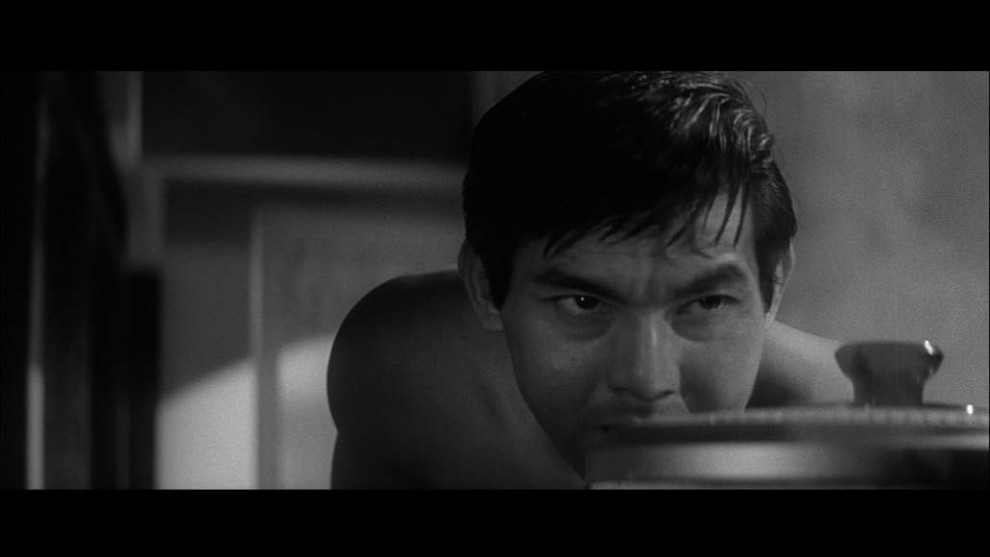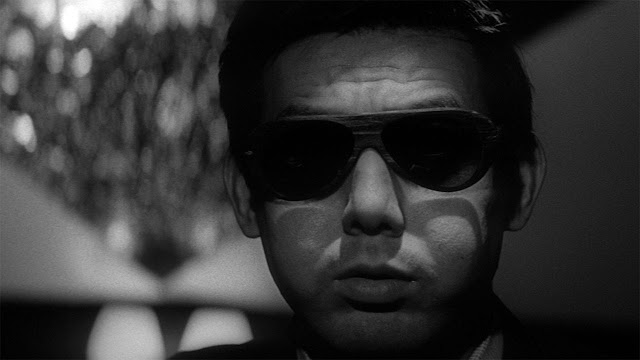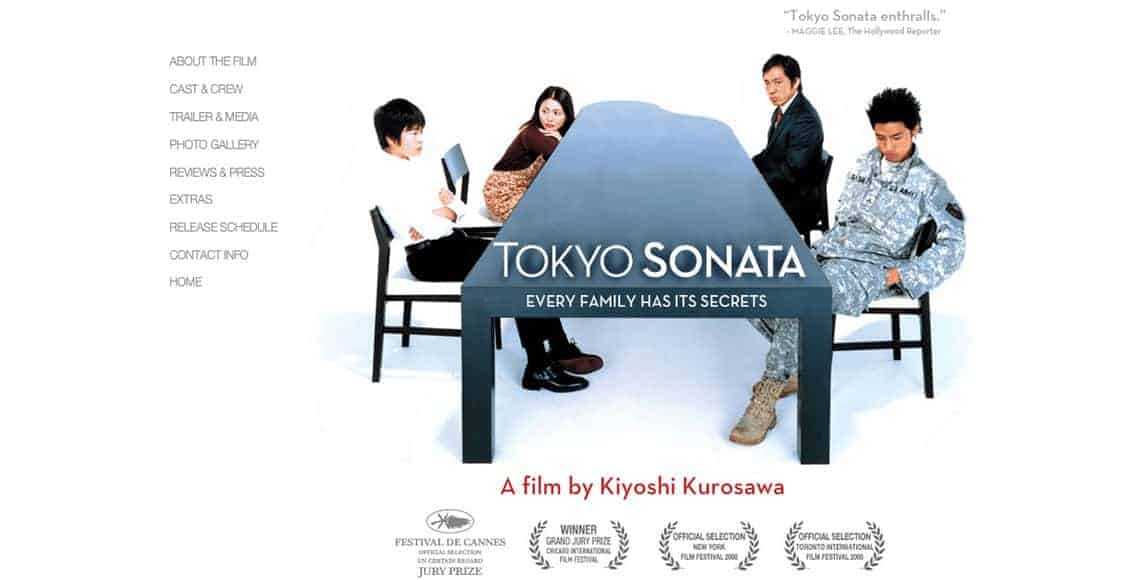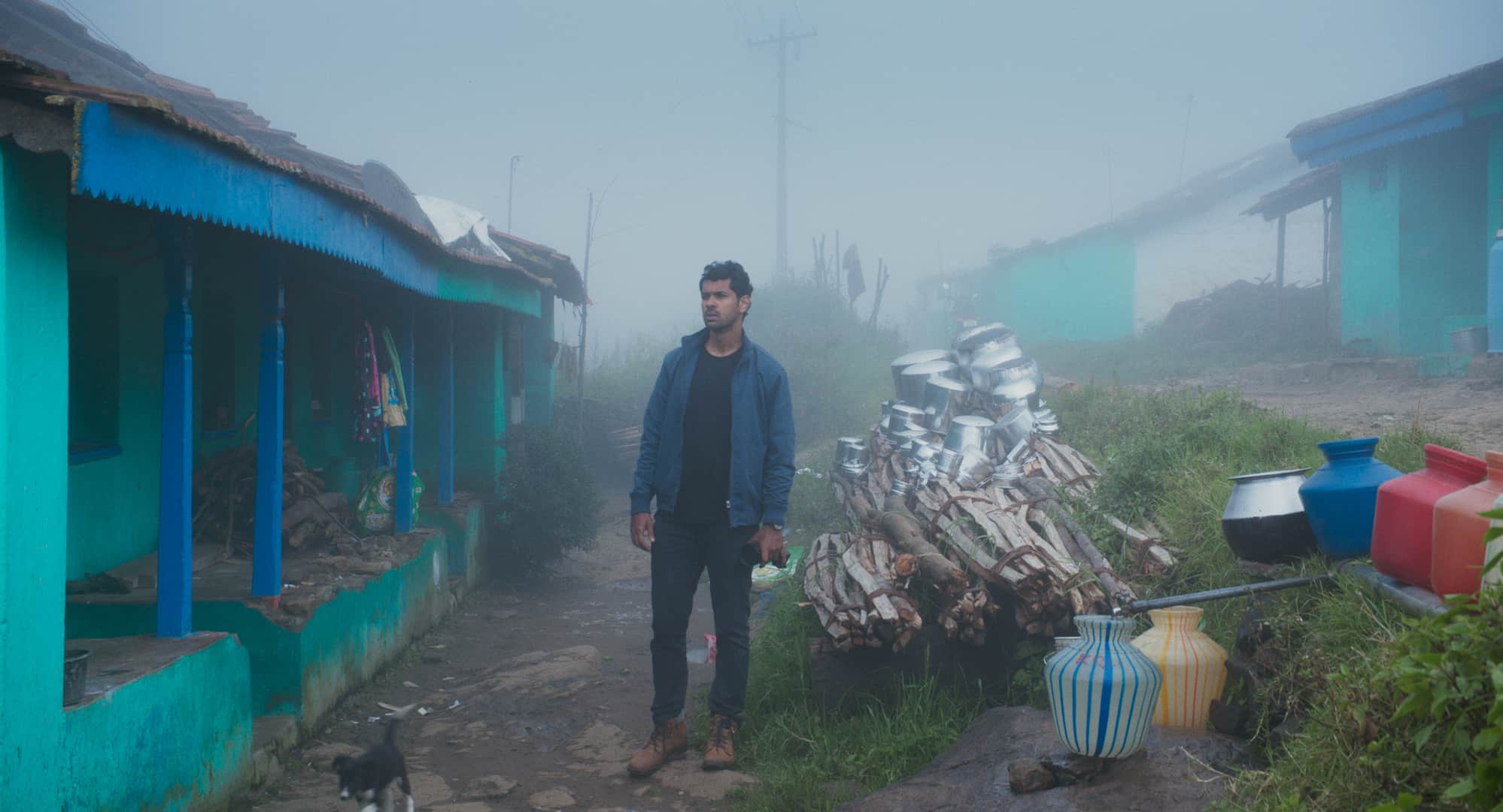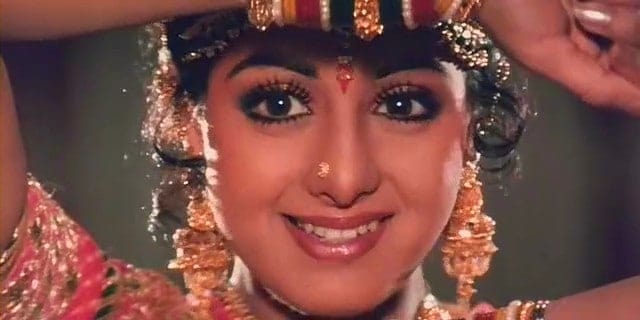“Branded to Kill” is Seijun Suzuki's absurdist nihilistic statement. A film compelled by Freudian drives, surreally, brought into the bright light of day. From this perspective, the utterly insane plot makes deranged sense. Suzuki worked with a team of writers, in a daring collaborative effort; to bash the out script in double quick time. The studio, Nikkatsu rejected the initial script by another writer. Suzuki took this to mean that the studio was out of ideas, so eight men frantically wrote a script, and Suzuki bolted it altogether in a riot of cinema!
Get The Original Poster from Japan Poster
Action and eroticism were the popular fashions in Japanese cinema through 1966/1967, so Suzuki intended to give the studio what they want! This slice of pragmatism led to him being fired, a long law-suit and being blacklisted for a decade.
“Branded to Kill” is an anarchic gangster film, jarring in tone, brutal in action and wild in sex, but awash with the deeply weird ideas, visually and expressed in the dialogue. A film driven by ideas, a pure stylistic cinema is always going to run into trouble at a mainstream studio. Nikkatsu expected an exploitative B-movie, a gangster filled with action thrills. This is exactly what they got; the action set pieces are exciting and inventive, as are, the sex scenes. Seijun Suzuki decided to fulfil genre expectations, but also to utterly subvert them. Throughout the film there is mad editing, preposterous plot developments, and explorations of dark philosophical themes, blended with satire, visual gags, and surreal comedy. Thrown into this brew is Kazue Nagatsuka's sensational noir, German Expressionistic, French New Wave black and white cinematography! “Branded to Kill” is a bubbling cauldron of cinema! The Studio was not pleased!
The Incomprehensible Plot
The bones of the story are very simple. Jô Shishido plays Gorô Hanada, the third ranked hitman in Japan. He is a cool, cruel and an efficient professional killer until he meet Misako, the death fixated beauty. Annu Mari, the Indian/Japanese actress is simply outstanding as Misako. She offers him a job that is botched, when a butterfly lands on his rifle's scope. The ‘organisation' sends in the mysterious Phantom Killer Number 1 to whack Hanada, for his incompetence. A fairly conventional gangster/hitman narrative, but the way the plot is driven by Suzuki; it is a macabre dance of death, with bizarre asides. The sheer amount of visual and audio experimentation is mind boggling, contrasted with the most direct dialogue this side of Sam Fuller. “Branded to Kill” is a wild ride of satirical nihilism, where Eros is completely stamped on by Thanatos.
Harmonica Jazz
The soundtrack by Naozumi Yamamoto is minimalist in approach, apart from the occasional audio gag. Most of the music is a stripped down mix of jazz drums, double bass and harmonica. The occasional addition of harpsichord is genuinely innovative. The harmonica/harpsichord is an unusual combination, and is suitably dreamy for this strange film. The wailing of the harmonica ebbs and flows depending on the needs of the scene, accompanied by the harpsichord, when necessary.
Genre Expectation Fulfilled
Right from the beginning of the film genre expectations are subverted. Hanada flies back into to town with his gorgeous and fashionable spendthrift wife, Mami. ‘The Man Apart', has a wife! By absurdist ‘entertainment over logic', the taxi driver, Gihei Kasuga, who picks Hanada and his wife, is a former ranked killer and wants back in the game. He introduces Hanada to local Yakuza boss, Michiko Yabuhara, at his bar, who gives him a contract. Kasuga waxes lyrical about the dangers of woman and drink, for the professional killer. At the bar, Hanada demonstrates his sensibility by ordering boiled rice. His wife orders whiskey and she instantly takes a liking to the boss, Yabuhara . The film is packed with these strange moments. Hidden desires are brought out into the open!
HanadaI can't help smelling your perfume
The opening action scenes fulfil genre expectation. Hanada efficiently blows away goons as they're ambushed twice. His job is to drive the mysterious Client, a big shot from ‘The Organisation', from Sagami Beach to Nagano, for 5 million yen.
The taxi driver who facilitates things, starts to fall apart as they drive The Client, his nerves shred with tension, and eventually hits the bottle. The interactions in the car, give cinematographer Nagatsuka the opportunity to create playful frames in the classic noir style, eyes in the car mirror, flashes of bright light on the eyes of The Client, shadows swirling around him. The complicated lighting perfectly realised. When Hanada reports to the Yakuza boss, Mami is already in bed with Yabuhara, she is moving up the foodchain!
One of the most bizarre kills of the film is the demise of boozing taxi driver Kasuga. Hiroshi Minami plays Kusaga's decent into a drunk and humiliated mess with aplomb. Kasuga dances around, dodging bullets, ashamed. In a suicidal charge, he rushes ranked killer Number 4, Koh. Cinematographer Nagatsuka frames Koh standing stylish at the bottom of tunnel, in the light. Kasuga walks through the tunnel, all white tiles in high contrast. These are superbly framed shots, building up a peculiar tension. Kasuga sprints towards Koh, eyes wide, mouth frothing, like a feral animal. Kasuga and Koh hug, as shots ring out. Kasuga drops and Koh finishes him off coolly, with his silenced pistol, satisfied. He walks away talking off his fashionable jacket, then promptly falls over, covering his own head with the jacket, and dies! A surreal, but professional way to die. The Client is unimpressed with Kasuga's lack of professionalism, three bodies lying on the ground, dead.
Hanada deals with ranked Killer No.2, Sukura, in shootout at a concrete bunker. He throws a petrol canister, and shoots it, setting Sukura on fire. In a bravura stunt scene, Sukura runs and burns for many metres, across the dust and brush, charging to the Volkswagen Beetle, trying to shoot The Client. A professional to the end! The Client finished him off cleanly, with his pistol. Hanada wonders if he is a ranked killer.
Buy This Title
‘I Hate Men'
When Hanada's car breaks down, in the pouring rain, matters turn very strange. A classy convertible drives by and stops for Hanada, open top in the rain! A mysteriously beautiful woman, completely soaked, is driving. Misako Nakajo is played to perfection by Japanese/Indian actress Annu Mari. She gives Hanada a lift and he is enchanted by her beauty. Sex and death come into conflict.
Hanada Are you married?
Misako I hate men
Hanada Then you have no hope.
Hanada My hope is to die
This brilliant pithy, concise dialogue is one of the inventive features of “Branded to Kill”. No flab, straight to the point, giving it a pugilistic poetic quality.
Hanada notices a dead Mynah bird attached to her car mirror, like a decoration, a nail in its throat, water spraying everywhere!
‘You're Only Nice To Me When We're Having Sex'
Hanada sniffs rice; Mami skips around the house naked. They live in a fine bourgeois apartment, minimalist with fashionable modern conveniences and furnishings. The geometric cinematography perfectly captures the hip and trendy apartment, and the set design by Sukez Kawahara aptly describes their upwardly mobile status. Once Hanada reaches sexual arousal, with his boiled rice sniffing, it's to ecstatic acrobatic sex with the wildly energetic Mami. Sex on the spiral stairs, all over the house! A bacchanal carnival of desire and boiled rice! Suzuki satirically keeps cutting back to the empty bed. Eros fights back in this great scene!
Mariko Ogawa is outstanding as the ambitious dynamic wife, a cheerful femme fatale! She likes to spend cash, be fashionable. She uses her bubbly, overt good time sexuality as the key to her ambition, but she is playing with fire. From what I can gather, Mariko Ogawa never featured in another film, which is shame, as she has a raw direct energy sparking off the screen.
Comic Strip kills
Over the next few scenes, Seijun Suzuki goes all James Bond. Hanada receives several contracts, highlighting his professional death dealing. These scenes are full of visual gags, satirical of corporate Japan and consumerism. The action sequences are very exciting.
Customs Officer, Railway Station
Hanada hides behind a mechanical lighter advert, where a big finger flicks the lighter, opening a gap for his rifle. Bang! Killed by consumerism! A lingering static shot of the Customs Officer, dead in the dirt by the track side. A witty but cruel juxtaposition between of the lack of dignity in the customs officer's death with the jokey assassination set up.
Dr Hino Oculist, Nagatacho Building
Dr Hino pulls a glass eye out of manikin's head, gung flops out of the hole. This is a witty nod to Bunuel/Dali. He palm slaps the glass eye in his patient's empty socket, slapstick style! Hanada loosens a water pipe in the basement. Dr Hino washes something in the sink. Boom, the top of his head is blown clean off! He is shot through the water pipe by Hanada, demonstrating his Number 3 status! Again the comedy killing is offset with a great special effect, the gruesome hole in the top Mr Hino's head.
Jeweller, Nakamori Building.
Hanada walks in the corporate office, blows away two goons, shots the receptionist, who is left spinning on his chair, behind an absolutely huge reception desk. Hanada opens some sliding doors, steps outside, and we assume, he is going to fall to his death! This office is on the upper floors of a high-rise corporate building. It is odd that there is a sliding door in this high rise room! Luckily a random advertising air balloon is floating outside, so Hanada lays down on top of the balloon to shoot the jeweller. The Jeweller appears, running a round in panic seeing the three dead bodies. It is assumed Killer Number 3 despatches the Jeweller from top of the floating balloon! This whole series of surreal absurdities makes for a well-choreographed and memorable action scene.
‘I Want You To Kill A Foreigner!'
Misako mysteriously re-appears, in the soaking rain, and asks Hanada to kill a foreigner. Reluctantly Killer No.3 takes the contract. Misako escorts the foreigner out of a hotel, but the hit is a botch. Hanada misses, as a butterfly lands on his rifles' scope! A delirious moment, but he accidentally kills an innocent woman instead. Misako passes judgement.
Misako You're finished you've lost your rank
Someone will come to kill you now
You're going to die
Hanada Die?
Misako Have you ever seriously contemplated death?
Fountains are spraying!
‘We're Just Beasts'
Another finely framed scene by Nagatsuka, Harada and Mami are in the bath, the shower is spraying! Jô Shishido, in an interview, says that many of the strange physical poses throughout Branded To Kill are from Degas. Suzuki directed the actors, by showing them art prints of Degas, and the various poses he painted of human beings. The bath scene is such a scene based on Degas.
In the bath his wife despairs,
Mami We're just beasts
A beast needs a beast
And we'll die like beasts
Death starts to stalk his wife's thinking.
Hanada wants to get out of town, but his wife dashes into the room, naked with a gun, and shoots him. Running out, she sets fire to their flash pad. Hanada stumbles up; his belt buckle stops the bullet! The fire flares up the spiral stairs, he staggers out. A fire vortex bursts through the spiral staircase. This is a great shot captured by Nagatsuka, in unnerving style. The external shot of the apartment fire is framed by more vivid cinematography. Geometric angles, lines of architecture, contrast with the diagonal line of fire. Both fire scenes are very expressionistic, not unlike a Universal horror flick from the 1930s, the fires of hell licking.
Observing this fiery drama is Misako, she is standing by some more fountains! In noir style, her white expressionless face contrasts with shadows shrouding her. She suddenly smiles an evil knowing smile. Annu Mari's acting, from impassive emptiness to pure wickedness, is excellent. There are many extreme close ups of her face, so her transformations of expression have to be immaculate, expressing her impulses against her antagonistic emptiness. The shadows that cloak her are a truer reflection of her inner nothingness. She is a cinematic illustration of contemporary horror writer, Thomas Ligotti's nihilistic metaphor of The Shadow.
The Butterfly Collector! Eros! Thanatos! A Gothic Farce!
Hanada somehow staggers to Misako's apartment and falls into a gothic delirium. The production/art design and cinematography in this importance scene, is beyond inventive. Misako's apartment is shrouded in shadow, but where light falls on the walls, hundreds of butterflies and moths are skewered with pins or needles. Misako gives Hanada a deathly smile from the shadows. When Hanada collapses, Misako pounces on him, but Hanada pulls a gun on her. She wipes blood off him, and she walks into the shower, her clothes on, to rinse off the blood. Hanada's desire is fired by her weird behaviour and beautiful face, he orders her to strip off! She threatens him with a poisoned needle! Hanada can only reply, ‘I want to eat rice'!
The sheer volley of weirdness, desire, nonsensical gothic atmosphere and the interaction of Jô Shishido and Annu Mari, is a barrage on the senses. This whole sequence is the heart of the film. The battle between Eros and Thanatos is at its most intense. Emptiness, the urge to nothing, battles with yearning and human touch. The death dealer and the death seeker, somehow humanise each other, as they battle their strange impulses. This scene is a demented melodrama with farcical comings and goings.
Misako's white face looms into focus, through the shower water, she smiles. Hundreds of butterflies pinned to the wall! Dizzying Lepidoptera everywhere! Nagatsuka captures this hallucinatory scene with gusto, an uncanny light and shade palette, zooms and panning through the room. The set design, lighting, acting and direction of this whole scene is high art.
Hanada eats his rice, and puzzles over Misako
Hanada It's like a cemetery
Misako Where can I pierce you?
Hanada I wanted to embrace you
In a birdcage, two birds are singing sweetly. Misako says she likes mynah birds! Hanada holds a gun and takes off her shoes. He tries to embrace her, but gets a handful of butterflies. Misako is laid out like a corpse, staring emotionless, completely possessed by The Shadow. She pulls a gun and fires, Hanada runs off. Now there is a comedy voyeuristic shot of Misako, through a keyhole, pulling up her tights! The jarring shots continue. Hanada escapes the apartment on a makeshift rope of bedsheets! There is a gunshot through a towel! Disorientating images, shifts in tone, through a series of swift edits!
A seemingly emotionally empty Misako starts peeling wings off the dead butterflies, an automaton of delicious despair, but is she reacting to Hanada? Hanada returns to the butterfly den, and knocks Mariko's pistol out of her hand. In a moment of frenzy he starts to tear off Misako clothes, a possible threat of sexual violence, but Hanada stops.
Hanada I'll kill you
That's what you're hoping for
She reposes in anguish opening her throat to the inevitable, but Hanada's heart melts and he can only hug her, all thoughts of violence disappear. Her strange impassive search for death is unsettling the death dealer, empathy creeps into his heart. Misako expresses her emptiness, her sadness, her wickedness in an expressionistic performance by Annu Mari, she is magnificent.
They finally have sex, Hanada kissing Misako intensely, but she is passionless and impassive, a large moth/butterfly observes the action from a light fitting! Hanada finally grabs a gun and points it between her breasts, she is unresponsive and emotionless. The camera slowly starts to pan down her naked body, the moth settles over her private parts. The birdcage is knocked over, the Mynah birds dead, skewered by pins! Hanada disturbed leaves Misako's apartment in a blouse!


